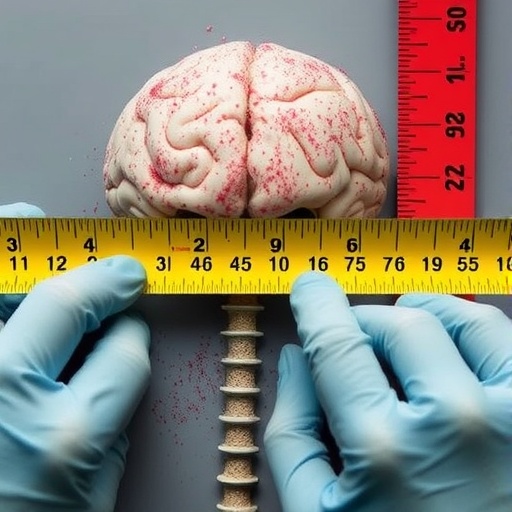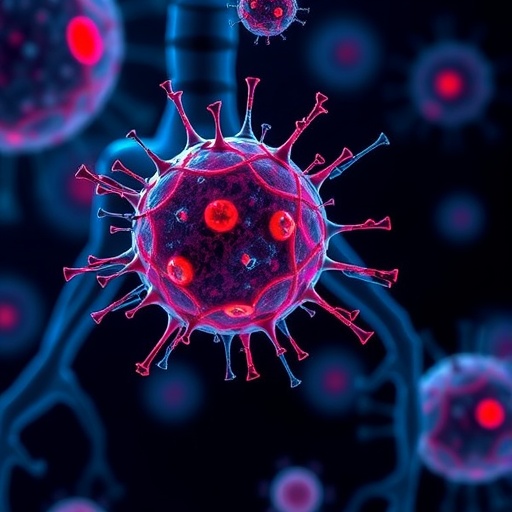In a groundbreaking study that promises to reshape the forensic analysis of violent deaths, researchers have for the first time successfully quantified the stabbing intensity involved in an intracranial stabbing death. This landmark investigation, spearheaded by Zwirner, Vollmer, Scholze, and their colleagues, harnessed experimental methodologies to elucidate the precise physical forces exerted during one of the most severe and complex types of assaults involving sharp instruments penetrating the skull. The results, recently published in the International Journal of Legal Medicine, offer unprecedented insights that are poised to bolster forensic accuracy in determining the dynamics of such lethal encounters.
Intracranial stabbing deaths are notoriously challenging to analyze due to the intricate interplay of biomechanical forces required to breach the human skull. Unlike superficial stab wounds, penetrating the cranial vault involves overcoming considerable resistance from the cranial bones and underlying tissues. Until now, forensic pathologists have largely relied on qualitative assessments and circumstantial evidence to infer the force behind such injuries, with quantitative data being scarce or non-existent. The present study filled this critical gap by experimentally measuring the stabbing forces under controlled conditions, facilitating a more scientific and empirical approach to case evaluations.
Central to the study’s methodology was the design of an experimental setup capable of reproducing stabbing motions with variable intensities against synthetic skull models mimicking human cranial properties. By integrating advanced sensor technologies and high-speed data acquisition systems, the researchers meticulously recorded the magnitudes and profiles of forces applied during simulated stabbing events. These experiments were calibrated to replicate realistic scenarios encountered in forensic casework, ensuring that findings would be directly translatable to actual autopsy and investigative contexts.
The team’s approach involved not only quantifying the peak forces necessary to penetrate the skull but also analyzing the rate of force application and its temporal characteristics. Such dynamic measurements are particularly crucial because stabbing motions differ significantly in velocity and forcefulness depending on the assailant’s intent, physical strength, and weapon type. By capturing this nuanced data, the researchers could distinguish between defensive injuries, accidental penetrations, and lethal assaults, offering forensic experts a powerful tool to contextualize and interpret cranial stab wounds with greater precision.
One of the most striking revelations from the study was the unexpectedly high force threshold required to achieve intracranial penetration. Contrary to prior assumptions that relatively moderate force could suffice with sharp-edged weapons, the experiments demonstrated that substantial mechanical energy input is necessary to overcome the composite multilayered resistance of the skull, periosteum, and brain matter. This insight challenges some prevailing forensic interpretations and underscores the lethal intent and physical exertion typically involved in such fatal encounters.
Moreover, the researchers explored how different types of stabbing instruments—their blade geometry, sharpness, and weight—influence the stabbing force needed for intracranial penetration. Through comparative trials involving a range of knives and pointed tools, the study revealed that weapon characteristics significantly affect both the force magnitude and injury patterns. This empirical evidence empowers forensic analysts to reconstruct attack scenarios with enhanced specificity, potentially linking wounds to particular weapons recovered at crime scenes.
Beyond the mechanical quantification, the study also delved into the biomechanical implications of intracranial stabbing injuries. By correlating force data with simulated tissue disruption, the investigators illuminated how stabbing intensity correlates with fatal brain trauma severity. These findings have profound implications for forensic pathology, suggesting objective parameters to differentiate between varying degrees of cranial stab injuries and their likely lethality. This could materially impact legal outcomes by clarifying the nature of the assault in ambiguous cases.
The implications of this research extend beyond forensic science into the realms of criminal justice and public safety. The ability to rigorously determine the stabbing force applied in intracranial deaths can influence judicial proceedings by providing concrete scientific evidence regarding the aggressor’s intent and the circumstances surrounding the death. This may enhance the evidentiary foundation upon which verdicts are reached, reducing wrongful convictions or acquittals caused by misinterpretation of injury severity.
This pioneering study also opens new avenues for developing forensic training protocols. By integrating knowledge of stabbing intensity thresholds into educational curricula, future pathologists and crime scene investigators can hone their skills in injury interpretation and scene reconstruction. The experimental data established by Zwirner and colleagues could become a benchmark reference, enabling more standardized and reproducible assessments across forensic institutions worldwide.
While the study achieved significant strides, it also highlighted areas ripe for further exploration. For instance, the variability in human cranial anatomy due to age, sex, and genetic factors was noted as a potential variable affecting force thresholds. Future research could expand on these dimensions by incorporating cadaveric specimens or computational modeling to simulate a wider array of physiological conditions, refining the universality of the conclusions drawn thus far.
Collaboration across disciplines was fundamental to the success of this work. The interdisciplinary team combined expertise from forensic medicine, biomechanics, materials science, and engineering, illustrating the power of integrating diverse academic perspectives to solve complex forensic problems. Such collaborative models serve as exemplars for how contemporary forensic challenges may be addressed in the future, leveraging cutting-edge technology and cross-domain knowledge.
The publication in the International Journal of Legal Medicine ensures wide dissemination among forensic practitioners and researchers, catalyzing knowledge transfer and stimulating discourse on the standardization of force measurement in stabbing-related fatalities. It is anticipated that these findings will prompt the revision of forensic protocols and guidelines, embedding quantitative force analysis as a core component in forensic investigations involving cranial stab wounds.
In conclusion, this experimental determination of stabbing intensity in intracranial stabbing deaths represents a landmark advancement in forensic science. By precisely measuring and characterizing the forces behind one of the most violent and devastating forms of assault, the researchers have empowered forensic examiners with objective tools to interpret complex injuries more accurately. This scientific breakthrough holds the promise of transforming legal outcomes, improving forensic training, and ultimately contributing to justice and public safety in cases of violent death.
Subject of Research: Experimental determination of the force intensity involved in intracranial stabbing deaths.
Article Title: Experimental determination of the stabbing intensity in an intracranial stabbing death.
Article References:
Zwirner, J., Vollmer, M., Scholze, M. et al. Experimental determination of the stabbing intensity in an intracranial stabbing death. Int J Legal Med (2025). https://doi.org/10.1007/s00414-025-03622-y
Image Credits: AI Generated
Tags: cranial injury examinationexperimental methodologies in forensicsforensic biomechanics researchforensic science advancementsintracranial homicide analysislegal medicine studiesquantitative forensic pathologysharp instrument assault dynamicsskull penetration resistance analysisstabbing force measurementstabbing intensity quantificationviolent death investigations





